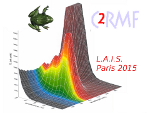In this study we date directly, for the first time, an example of a desert kite structure in the southeast of Jordan using luminescence signals from buried rock surfaces. These kites consists of two long low stone- walls lead outward in a funnel-like shape, often with some sort of stone enclosure where the walls meet; they are presumed to be animal traps used by hunters. Little known about the age of these kites because of an absence of attributable artefacts, and the lack of organic matter suitable for carbon dating.
The luminescence samples were taken from recently excavated kite in Jibal al-Ghadiwiyat in the east of al-Jafr (south-east Jordan). One rock sample was excavated from a pit in the kite enclosure; the sample was part of a long upright slab that forms part of the wall of the pit. Sediment samples from the infill of the pit were also collected for single grain measurements. The quartz from both the sandstone construction materials and the infill sediments (accumulated since site abandonment) are very suitable for luminescence measurements (high sensitivity, fast-component dominated).
The luminescence depth- profile through the rock slab shows the history of sequence of burial and daylight exposure for the two surfaces (the inward and out ward of the standing slap) Figure 2. Preliminary results from the fitting model of Sohabati et al. (2011) and Freiesleben et al. (2015) gives a construction age of ~6.3 ka from the exposed and ~6.5 ka from buried (during use), indicating that the kite was not in use for a prolonged period.

 PDF version
PDF version
